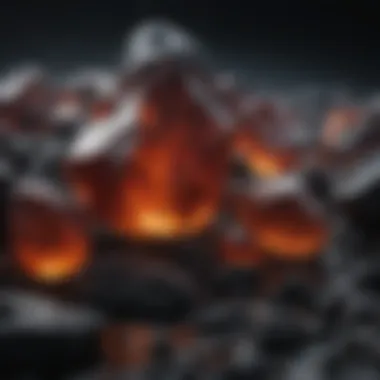Unveiling the Intriguing World of Black Rocks: A Comprehensive Exploration


Rock and Fossil Identification
Black rocks, ranging from the glossy volcanic obsidian to the smooth metamorphic slate, offer a plethora of types in nature that captivate enthusiasts. Understanding the key characteristics and formations of these rocks is essential for collectors and geology enthusiasts alike. Observing the texture, color, and composition are crucial in identifying different types of rocks. Paleontologists examining fossils must pay attention to specific details such as bone structure, texture, and imprint markings. Utilizing tools like magnifying glasses, rock hammers, and UV lights enhances the identification process.
Collecting Tips and Techniques
Embarking on a rock collecting journey requires following specific protocols to ensure success and safety. Expert collectors suggest researching prime collecting sites known for their rich deposits of black rocks. Safely extracting specimens involves using gloves, goggles, and proper tools to prevent injuries. After locating a potential rock, carefully extract it with minimal disturbance to the environment. Adhering to ethical practices by not collecting from protected areas is crucial in preserving the natural heritage.
Preservation and Display
Preserving black rocks and fossils involves employing various techniques to maintain their integrity and beauty. Methods such as sealing rocks with clear finishes to protect them from the elements and storing fossils in airtight containers to prevent deterioration are common practices. Creative display ideas, such as shadow boxes or glass cabinets, allow collectors to showcase their prized specimens while protecting them from dust and damage. Implementing proper storage methods like using acid-free paper and avoiding direct sunlight helps in preserving the vitality of the collection.
Geological Insights
Delving into the geological significance of black rocks unveils a rich tapestry of history and processes. Exploring the formations and processes that lead to the creation of these rocks provides insights into Earth's past and present geology. Tracing the historical significance of certain rocks or fossil discoveries adds a layer of intrigue to their allure. Notable discoveries, such as unique fossilized specimens or rocks indicating ancient volcanic activity, offer valuable insights into the planet's evolution and geological events.
Introduction
The pivotal section of this article, the Introduction, serves as the gateway into the intriguing world of black rocks. It lays the foundation for the subsequent exploration by shedding light on the significance and complexity of these enigmatic geological entities. The importance of understanding black rocks goes beyond mere curiosity; it offers valuable insights into the Earth's history, geology, and natural processes.
Understanding the Diversity of Black Rocks
Volcanic Black Rocks
Within the realm of Volcanic Black Rocks, a profound exploration of materials like Basalt and Obsidian unravels. Basalt, known for its robustness and durability, showcases intricate formations such as Columnar Basalt and Pillow Basalt, each telling a unique geologic tale. Obsidian, with its glassy texture, manifests in varieties like Snowflake Obsidian and Mahogany Obsidian, captivating collectors and researchers alike with its alluring properties. The exclusive characteristic of Volcanic Black Rocks lies in their origin from volcanic activity, rendering them as both aesthetically pleasing and scientifically valuable entities within the spectrum of geology.
Metamorphic Black Rocks
Metamorphic Black Rocks delve into the transformative nature of materials like Slate and Schist. Slate, boasting hues of black and green, embodies elegance and versatility - from Black Slate to Green Slate, exemplifying the spectrum of metamorphic possibilities. Schist, with formations like Mica Schist and Garnet Schist, highlights the complexity and diversity of metamorphic processes, offering a window into the Earth's geological history. Metamorphic Black Rocks, with their intriguing textures and structures, enchant observers with their metamorphic journeys, making them a focal point of geological studies and aesthetic appreciation.
Sedimentary Black Rocks


Sedimentary Black Rocks unveil the sedimentary origins behind materials like Shale and Lignite. From Black Shale, with its stratified layers, to Oil Shale, known for its organic richness, these rocks narrate tales of ancient environments and sedimentary deposition. Lignite, represented by Jet and Coal, carry remnants of past habitats and organic matter, offering insights into historical climates and ecological conditions. The uniqueness of Sedimentary Black Rocks lies in their formation through sediment accumulation, portraying a visual tapestry of Earth's evolution and environmental fluctuations.
Significance of Black Rocks in Geology
Historical Significance
Exploring the Historical Significance of Black Rocks unveils a narrative intertwined with geological epochs and ancient landscapes. These rocks bear imprints of past geologic events, tectonic movements, and environmental changes, serving as windows to bygone eras. Understanding their historical context provides geologists and enthusiasts with valuable information on the Earth's dynamic past, enriching our knowledge of geological processes and planetary evolution.
Geological Applications
The practical significance of Black Rocks in Geological Applications extends to various fields such as petrology, mineralogy, and geochronology. These rocks serve as indicators of past environments, mineral resources, and geologic events, facilitating geological reconstructions and interpretations. Their unique compositions and structures enable researchers to unravel geological mysteries and reconstruct the Earth's history, making them indispensable tools in the realm of geology and earth sciences.
Volcanic Black Rocks
In this comprehensive guide on black rocks, the section on Volcanic Black Rocks holds significant importance due to the fascinating nature of these geological formations. Volcanic black rocks are born from the intense heat and pressure beneath the Earth's crust, resulting in unique textures and compositions that intrigue both collectors and geologists. Understanding the specific elements and benefits of volcanic black rocks is crucial for appreciating their geological significance.
Basalt
Columnar Basalt
Columnar Basalt is a prominent member of volcanic black rocks, known for its distinctive vertical columns that form during the cooling process of lava flows. These columns create visually striking landscapes and provide essential insights into the geological history of an area. The key characteristic of Columnar Basalt lies in its hexagonal prism-shaped columns, showcasing the systematic patterns of crystallization that make it a valuable inclusion in this article. The unique feature of Columnar Basalt lies in its alignment, which reflects the directional cooling of lava, offering valuable information for geological studies.
Pillow Basalt
Pillow Basalt, another notable variety of volcanic black rocks, forms when lava erupts underwater, creating pillow-shaped structures due to rapid cooling. These formations are essential indicators of past underwater volcanic activities and play a crucial role in deciphering ancient subsea volcanic events. The key characteristic of Pillow Basalt is its rounded morphology, resembling large pillows stacked together, making it a distinctive and informative choice for exploration in this article. The unique feature of Pillow Basalt lies in its association with underwater volcanic environments, providing insights into the dynamic processes shaping the Earth's crust.
Obsidian
Snowflake Obsidian
Snowflake Obsidian, a captivating type of volcanic glass, is characterized by unique snowflake-like patterns of cristobalite crystals dispersed throughout its dark body. This distinctive appearance sets Snowflake Obsidian apart from other black rocks, making it a sought-after material for both aesthetic and metaphysical purposes. The key characteristic of Snowflake Obsidian is its delicate white crystal inclusions, enhancing its beauty and allure in collectors' circles and geology enthusiasts' repositories. The unique feature of Snowflake Obsidian lies in its reflective properties, symbolizing purity and balance within the realm of black rocks.


Mahogany Obsidian
Mahogany Obsidian, distinguished by its rich brown and black hues, carries a warm and grounding energy that resonates with individuals seeking stability and protection. The key characteristic of Mahogany Obsidian is its earthy tones and glassy luster, offering a unique blend of beauty and metaphysical significance for those drawn to its enchanting appeal. The unique feature of Mahogany Obsidian lies in its ability to promote strength and resilience, making it a valuable inclusion in this article for its profound symbolism and geological intrigue.
Metamorphic Black Rocks
In the realm of black rocks, metamorphic varieties hold a unique significance that adds depth and complexity to the world of geology. Unlike the rapid formations of volcanic rocks or the gradual processes of sedimentary rocks, metamorphic rocks undergo intense heat and pressure transformations deep within the Earth's crust. This section sheds light on the distinct characteristics and captivating allure of metamorphic black rocks, enriching our understanding of these natural wonders.
Slate
Black Slate
Black slate stands out as a quintessential example of metamorphic black rock, revered for its sleek appearance and versatile applications. Its deep black hue, often juxtaposed with subtle veins of gray or white, exudes a sense of sophistication suitable for a range of design purposes. Within the context of this article, black slate emerges as a prime exemplar of refined elegance in the realm of metamorphic black rocks. Its smooth texture and fine-grained composition make it a popular choice for both practical and aesthetic uses, such as roofing, flooring, and decorative accents. The unique feature of black slate lies in its inherent strength and durability, making it a reliable option for various construction and design projects showcased in this comprehensive guide.
Green Slate
Conversely, green slate offers a refreshing twist within the spectrum of metamorphic black rocks, showcasing a verdant hue that sets it apart from its darker counterparts. The subtle interplay of green tones accentuated by earthy textures imbues green slate with a natural charm that resonates with environmental enthusiasts and design connoisseurs alike. In the context of this article, green slate's key characteristic lies in its aesthetic versatility, capable of adding a touch of organic vibrancy to architectural elements and interior designs. The unique feature of green slate lies in its ability to evoke a sense of tranquility and connection to nature, making it a favored choice for eco-conscious projects highlighted throughout this comprehensive guide.
Schist
Mica Schist
Mica schist, a prominent member of the schist family, embodies a shimmering allure that captures the imagination of geology enthusiasts and collectors. Its distinctive layers of mica impart a subtle sheen to the rock's surface, creating a visual spectacle that exemplifies the beauty of metamorphic processes. Within the framework of this article, mica schist's key characteristic lies in its lustrous appearance and tactile appeal, drawing attention to its mesmerizing aesthetics and geological significance. The unique feature of mica schist lies in its reflective quality, which adds a mesmerizing dimension to the specimens featured in this comprehensive guide.
Garnet Schist
Garnet schist, adorned with deep red garnet crystals embedded in a matrix of fine-grained minerals, symbolizes the intricate interplay between geological forces and natural beauty. Its striking coloration and textural contrasts make garnet schist a standout specimen in the world of metamorphic black rocks. Within the narrative of this article, garnet schist's key characteristic lies in its ornamental appeal and symbolic value, underscoring its allure as a collector's item and geological marvel. The unique feature of garnet schist lies in its vibrant hues and crystalline formations, making it a captivating focal point in the curated selection of metamorphic black rocks presented in this comprehensive guide.
Sedimentary Black Rocks
Sedimentary black rocks play a crucial role in this comprehensive guide as they offer a fascinating glimpse into the world of geology. These rocks are not only visually impressive with their deep, dark hues but also hold significant geological importance. In the realm of sedimentary rocks, black rocks stand out for their unique composition and formation processes.


Shale
Black Shale: Black shale is a standout among sedimentary black rocks, characterized by its rich black color that results from high organic content and the presence of minerals like pyrite. In this article, black shale serves as a prime example of the diversity within sedimentary rocks. Its fine-grained nature and layering make it a valuable choice for understanding ancient ecosystems and environmental shifts.
Intriguingly, black shale also holds historical significance, as it has been pivotal in revealing past climates and the evolution of life on Earth. Its dark coloration indicates periods of low oxygen conditions, offering insights into Earth's geological past and serving as a recorder of environmental changes over time.
Oil Shale: Another notable sedimentary black rock is oil shale, prized for its potential as a fossil fuel source. Oil shale's organic-rich composition holds kerogen, a precursor to oil, making it a promising energy resource. Within this article, oil shale's significance lies in its dual nature as a sedimentary rock and a potential energy source, underscoring the intersection of geology and energy production.
Along with its energy potential, oil shale presents challenges such as environmental impacts during extraction and processing. Despite these drawbacks, its inclusion in this guide sheds light on the complexities of utilizing natural resources and the need for sustainable practices.
Lignite
Jet: Within the category of lignite, jet stands out as a distinctive black fossil wood characterized by its lightweight yet durable composition. Jet's popularity in jewelry-making and ornamentation highlights its aesthetic appeal and historical use in adornments. In this article, jet's unique feature as a gem material with a deep black coloration adds a touch of elegance, appealing to collectors and enthusiasts seeking rare and beautiful specimens.
Coal: Coal, a ubiquitous black rock with profound historical and industrial significance, forms the final cornerstone of this section. Its widespread use as a source of energy underscores its economic importance and impact on global energy consumption. By delving into coal's key characteristics, such as varying carbon content and types like anthracite and bituminous coal, this article offers a nuanced view of coal's role in human history and its enduring relevance in modern society.
Through a meticulous examination of sedimentary black rocks like shale, oil shale, lignite (including jet and coal), this guide provides a comprehensive exploration of their geological, historical, and practical dimensions. By unraveling the intricacies of these rocks, collectors and geology enthusiasts can deepen their understanding and appreciation of the captivating world of black rocks.
Conclusion
Appreciating the Beauty and Diversity of Black Rocks
Artistic Value
Artistic Value holds a pivotal role in the allure of black rocks. The deep, rich hues and unique textures exhibited by these rocks offer a canvas for artistic expression unlike any other. Artists and artisans often leverage the striking contrast provided by black rocks to create compelling pieces that evoke a sense of mystery and elegance. The enigmatic nature of black rocks adds a distinct charm to any artistic creation, establishing them as a popular choice in the creative realm. While the stark black color may limit color options, it allows for a bold and sophisticated aesthetic that appeals to individuals seeking a dramatic and refined look.
Collector's Delight
For collectors of rocks and fossils, black rocks are a true delight. The rarity and diversity of black rocks make them highly sought after among collectors, adding a sense of exclusivity to any collection. Each black rock variation tells a unique geological story, enticing collectors with its individual characteristics and historical significance. From volcanic obsidian to metamorphic slate, the appeal of black rocks lies in their timeless beauty and intrinsic value. While collecting black rocks can be a rewarding hobby, it requires a discerning eye and a deep appreciation for the wonders of the Earth's natural formations.
Preservation and Care Tips
Cleaning Techniques
Effective cleaning techniques play a crucial role in preserving the beauty and integrity of black rocks. Gentle cleaning methods using soft brushes or cloths help remove dirt and debris without causing damage to the rock's surface. Avoid harsh chemicals or abrasive materials that may scratch or degrade the rock's appearance. Regular cleaning not only enhances the visual appeal of black rocks but also prevents deterioration over time, ensuring they remain pristine for years to come.
Storage Recommendations
Proper storage is essential to safeguard the quality of black rocks. Storing black rocks in a dry environment away from direct sunlight helps prevent discoloration and deterioration. Utilizing padded containers or individual compartments for delicate specimens prevents scratches and chips during storage. Incorporating desiccants or silica gel packets in storage containers aids in controlling moisture levels, preserving the natural beauty of black rocks. By following these storage recommendations, collectors can prolong the lifespan and maintain the allure of their black rock collection.







